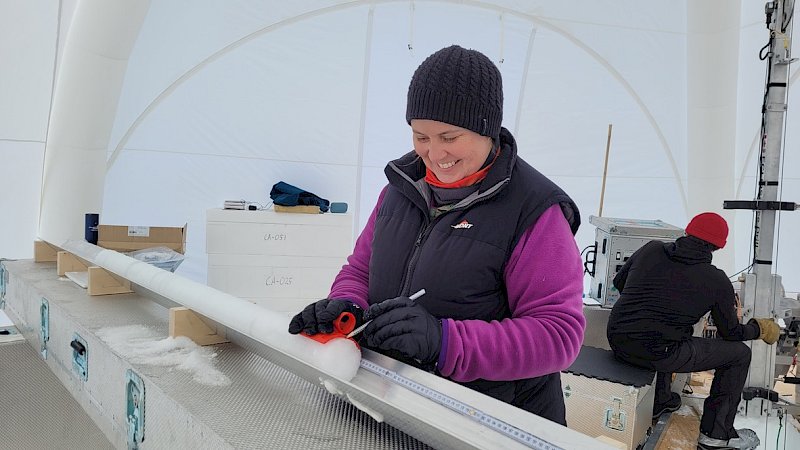The Australian Antarctic Program's new Chief Scientist, Professor Nerilie Abram, always knew she wanted to be a scientist, but it took a while to find her niche.
After flirting with physics she trained as a geologist, before eventually finding her way to climate research.
Some 20 years on, her substantial contribution to the field of climate science was recognized in 2024 when she was elected as a Fellow of the Australian Academy of Science, placing her among the nation's most eminent scientists.

In 2019 she was the Coordinating Lead Author of the Intergovernmental Panel on Climate Change (IPCC) Special Report on the Ocean and Cryosphere in a Changing Climate, and is a coordinating lead author again for the current assessment cycle.
She has also previously chaired the National Committee for Antarctic Research, which aims to foster Antarctic science in Australia and link national and international Antarctic researchers.
"I'm driven by a fascination for science and how the world works, but also delivering information that people need for making decisions about how we're going to be resilient to climate change," Prof. Abram said.
Looking to the future from the past
As a palaeoclimate scientist, Prof. Abram uses the Earth's climate archives, which include corals and ice cores, to reconstruct climate variability and change over time.
"I did my PhD on reconstructing climate in the tropics using corals," Prof Abram said.
"My work focused on the eastern Indian Ocean, off the coast of Sumatra, studying the natural variability of the Indian Ocean Dipole - which affects Australia's rainfall - and how it's changed over hundreds and thousands of years."
When she finished her PhD in 2004, it was a fairly natural progression to move into ice core research, with a position at the British Antarctic Survey.
"There are many similarities between using corals and ice cores to reconstruct climate history. The difference was I was working in a freezer instead of a nice warm laboratory," Prof. Abram said.
Her first visit to Antarctica in 2007 was to James Ross Island, near the tip of the Antarctic Peninsula, to drill a 364 metre ice core containing 1000s of years of climate history.
Her work proved to be an influential point in her research career. The ice core showed summer ice melting had increased 10-fold in the past 1000 years with the most rapid increase occurring in the past 50 years.
"It was the first long ice core that had been collected from the Antarctic Peninsula," she said.
"We showed that the recent warming of the peninsula was unusually fast compared to any of the natural variability in the region. We also showed how the climate in the region is related to how stable the nearby ice shelves are."
Since that first trip Prof. Abram has been to Antarctica a further four times, and twice to drill ice in the Arctic.
Her most recent visit to Antarctica was as part of the Antarctic Program's Denman Terrestrial Campaign in 2023, where she oversaw ice chip drilling - a first for Australia - near the Denman Glacier.
The chips will enable measurements of how the climate and weather have changed in the region over the past 500 years.
Unity in strategic direction
Prof. Abram said the role of Chief Scientist was a natural extension of her work, given the opportunity to shape the direction of Antarctic research and ensure its relevance to decision-makers.
"My career has been increasingly focused on how we bring scientific information together to produce impactful pieces of work and deliver that information to the people that need it," she said.
"The role of Chief Scientist will allow me to look strategically at what we need to do in Antarctica and to work with the Australian Antarctic science community to shape that."
Prof. Abram's appointment aligns with a new 10-year strategy outlining Australia's priority science to advance national interests in Antarctica, the Southern Ocean and sub-Antarctic islands.
It's a fresh opportunity to foster a unified and collaborative Antarctic science community, with a vision that's paired with logistical capabilities.
"We need to understand how Antarctica is changing, what that means for the rest of the world, and how we can best protect Antarctica," she said.
"As Chief Scientist I hope to bring the research community together to take ownership of the strategy and to coalesce around it."
Bringing it together
Scientific icebreaker RSV Nuyina, and Australia's renewed deep-field traverse capability, will be important in delivering the science priorities.
"As well as being a science platform in its own right, Nuyina is going to be particularly important in getting us to places that aren't easy to access from our stations," Prof. Abram said.
"Our field campaigns, such as the previous multi-disciplinary Denman Terrestrial Campaign and our current Million Year Ice Core project, will also be important in getting to the heart of scientific problems."
Making the most of existing data, infrastructure and resources will also be key to delivering impactful science.
"There's a lot of work that I think we can do with the information we already have, including from long-term monitoring projects," Prof. Abram said.
"I'll be looking at how we bring that information together and how we work with other nations to develop a big picture, integrated understanding of the Antarctic system.
"As part of that, Australia has also invested significantly in our own climate model and we need to continue to contribute to the development of that."
At the end of the day, Prof. Abram said doing science in Antarctica is always challenging and that being adaptable is key.
It's a trait she's personally honed throughout her career, and one that she will undoubtably draw on in her new role.
"The first time I went to Antarctica I stepped out of the helicopter, looked around and thought 'oh my goodness, what am I doing? I can't do this'.
"Then I took a few deep breaths and got on with it, and it was an amazing experience."






